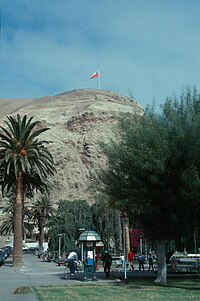Arica
Arica is a port city in northern Chile, located only 18 km (11 miles) south of the border with Peru. It is the capital of the Arica Province in the Tarapacá Region and has a population of approximately 200,000, and is also known as the "city of the eternal spring". The city was part of Peru until 1880, when it was invaded by Chilean forces during the War of the Pacific. The taking of the Morro de Arica, one of the war's most famous actions, happened in this city.

Features
The Morro de Arica (Arica Cape) is a steep and tall hill located in the city. Its height is 139 meters above sea level. It was the last bulwark of defence for the Peruvian troops standing in the city. It was assaulted and captured on June 7, 1880 by Chilean troops in the last part of their Campaña del Desierto (Desert Campaign) during the War of the Pacific.
Near the city is the Azapa Valley, an oasis where vegetables and Azapa olives are grown. Economically, it is an important port for Chilean ore, and its tropical latitute, dry climate, and the city's beach, have made Arica a popular tourist destination. It is also a centre of rail communication with Bolivia and has its own international airport. Arica has strong ties with the city of Tacna, Peru; many people cross the border everyday to visit this city, and also because many services (for example, dentists) are cheaper on the Peruvian side. Arica is connected to Tacna and to La Paz, Bolivia by separate railroad lines.
Arica is also known as one of the driest inhabited places on Earth, at least as measured by rainfall: average annual precipitation is 0.8 mm (0.03 inches), as measured at the airport meteorological station. Oxford geographer Nick Middleton's book on people who live in extreme climates, Going to Extremes (ISBN 0-330-49384-1), discusses his visit to this city.
Important events
- On August 16 1868, Arica was devastated by a tsunami which followed a magnitude 8.5 earthquake in the Peru-Chile Trench off the coast. The earthquake and tsunami killed an estimated 25,000 people in Arica and perhaps 70,000 people in all. [1]
- Arica was one of the four host cities of the 1962 football (soccer) World Cup.
